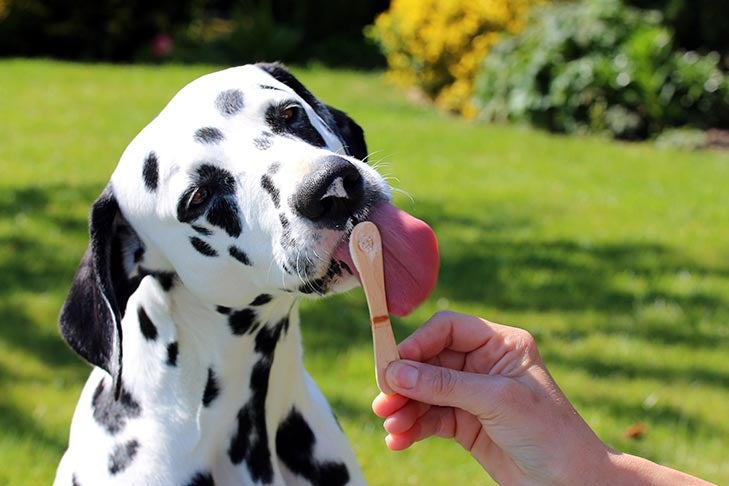Most people love ice cream. But is ice cream really a harmless treat for dogs, or will it cause a major bellyache?Unfortunately, although it may be tempting to share your cone with your four-legged friend, it’s best to avoid giving ice cream to dogs.
Why Dogs Can’t Eat Ice Cream
Lactose Intolerance
The first problem with ice cream is that dogs’ bodies are not designed to digest milk after they are weaned, as puppies. According to Dr. Jerry Klein, DVM, Chief Veterinary Officer for the AKC, puppies have the enzyme they need to break down their mother’s milk. After they are weaned, however, their bodies produce less lactase.

“Many adult dogs are lactose intolerant to varying degrees, which prevents them from properly digesting milk products,” says Dr. Klein. “If you feed these dogs milk products, they can experience anything from severe to mild gastrointestinal discomfort—loose stools, diarrhea, vomiting, stomach pain, or gas. Dairy products with high fat content can also cause pancreatitis in dogs.”
Food Allergies
Dogs can suffer from a variety of food allergies, including experiencing allergic reactions to milk and dairy products like ice cream. These allergies are a reaction to the proteins found in milk products and can manifest as vomiting and diarrhea and/or result in red, itchy skin rashes.
Obesity
Another problem with ice cream is that it is loaded with sugar, and feeding your dog sugary foods can lead to weight gain and obesity, which can cause other health problems. Even if the ice cream container says it’s sugarless, you need to be careful to read the label to make sure that no xylitol is used, as this sweetener is extremely toxic to dogs.
Toxic Flavors
The final problem with ice cream is that some flavors may actually be dangerous for dogs. Chocolate, for example, is toxic for dogs.

Alternatives to Ice Cream
High-quality dog foods contain enough calcium and other nutrients to help promote strong, healthy bones for your dog, so adding calcium to the diet of an adult dog with milk or ice cream is not at all necessary. While some dogs can tolerate a small amount of plain vanilla ice cream as a treat, there are other options you can give them that are not as likely to cause digestive problems.
If you want to give your dog a cold treat, freezing some fat-free plain yogurt might be a better choice. Because yogurt is fermented, it contains less lactose, so it’s easier for dogs to digest. Don’t feed your dog a commercial frozen yogurt, since it will be loaded with sugar. Use caution because although yogurt is easier for dogs to digest, not all canines can tolerate it.
Another good treat for dogs is “nice cream.” All you need are two ripe bananas and a food processor or blender. Blend the bananas until creamy, and freeze them. This fruit-based dessert is safe for dogs to eat,and provides some nutritional value. Bananas are high in potassium, vitamin B6, vitamin C, and fiber. They do contain sugar, so feed your dog bananas in moderation.
Ice cream maker Ben & Jerry’s has introduced a frozen nondairy dessert specially created for dogs. The company’s Doggie Desserts are icy treats made with sunflower seed butter. They come in two flavors: Rosie’s Batch, made with pumpkin and mini cookies, and Pontch’s Mix, made with peanut butter and pretzel swirls.
So whenever you’re thinking that there’s always room for ice cream for you and your best pal, keep your dog’s health in mind and try one of these or some other alternative snacks. Learn more about other human foods that are and are not OK for dogs here.

